The background
Growing up in South Africa in the second half of the 20th century, I was aware, mainly through history lessons at school, of the conflicts that took place between the Boers and the British forces in the latter part of the 19th century and the battles fought between both of them and the Zulus which preceded those conflicts.
However it never got beyond history lessons until we heard that John and Sam Denner were planning a 4 week visit to South Africa in February 2013, and that John in particular was very keen to visit as many of the battlefield sites as possible. Now, my sister Sam, or Sheila as we know her, has lived in Canada for 4 decades or so, but had visited us a few times in the intervening period – however we had never met John, our brother-in-law, although he did spend a year in SA in his 20’s.
We were aware of John’s passion for all things related to military events and the fact that he runs a business from their home in Canada trading in war memorabilia, weapons, uniforms and the like. What we came to realise as our tour of the battlefields progressed, is that his knowledge of the battles that took place in the 19th century is extensive and he often proved to be more knowledgeable than some of the local people we came across.
John sent a list of the sites they most wanted to visit and, because many of them were just names to me, it took some research via Google to establish locations, confirm travel routes and look at accommodation options. Between Sam and I we drafted an itinerary which allowed for visits to selected battlefields of the Northern Cape and Kwazulu-Natal, followed by a few days in Kruger Park and touring Mpumulanga, after which we would fly to George to spend some time in Mossel Bay and the Garden Route, then a brief visit to Cape Town before returning to Pretoria.
A few days were set aside to show them Pretoria and Johannesburg and to spend some leisure time in between the main parts of the tour. I had decided to take the time off myself and see some parts of the country that we had not experienced ourselves – and of course there would hopefully be a chance to do a bit of birding along with the other activities. The research I did on the battlefields had already pricked my interest to the extent that I was really looking forward to finding out more about the often turbulent history of South Africa.
The Arrival and first trip
John and Sam (Sheila) arrived on Tuesday 5th February 2013 on the early BA flight and we were at our home in Wapadrand, Pretoria by 9 am. After settling in and catching up a little, we decided to get “warmed up” for the touring ahead by taking a drive through Pretoria with stops at the historic Union Buildings and the Voortrekker Monument.
We could already see where their interests lay as John checked out the cannons at the Union Buildings and Sam enjoyed the curios on sale, with all of us admiring the good views over Pretoria.
The Voortrekker Monument was really worthwhile visiting, with its special aura and amazing carved reliefs – even the museum downstairs was full of interesting artifacts from the Great Trek era and it was immediately clear that John in particular has an affinity for the Boers and relates strongly to their ideals.
Off to Kimberley
We set off for Kimberley in the Northern Cape around 9 am on the following day, with a journey of some 650 Km ahead of us, taking the route via Krugersdorp, which we bypassed on the back roads, Carletonville, Potchefstroom, Klerksdorp and Bloemhof. It was a long drive with a couple of comfort stops, a stop for Steers Burgers in Bloemhof and a brief “look-in” at our son Stephan’s house on the outskirts of Potchefstroom to say hello to Liesl and the 2 kids, Jocelyn and Christopher.
The landscape changed from built-up Gauteng to the wide open landscape of the Northern Cape, with steps in between and eventually Kimberley appeared on the horizon at about 5 pm that afternoon – it was a quick decision to head out to Paardeberg museum and battlefield in order to recce before tomorrow’s planned visit, despite thinking that it would be closed at this time of the day.
Paardeberg Museum
Having found the Battle of Paardeberg site on Google Earth the previous day, we knew to head out on the N8 Bloemfontein road south-east of Kimberley for 44 Km and found the little museum without too much difficulty a couple of Kms off the main road near the “Perdeberg” station – the different spelling of “Paardeberg” almost put us off, but fortunately we followed our instincts.
Amazingly, we found the caretaker sitting outside the locked museum, despite it officially having “closed” an hour and a half before we arrived and, as if by magic, a local lady assistant appeared out of the bushes with a key to open the museum specially for us. From the visitor’s book entries it was clear that not many people visit this charming museum, which made us even more appreciative of having found the caretaker at his post.
We spent the next half hour going through the exhibits which set out quite nicely the background and events leading up to the battle and the battle itself.


Paardeberg Battlefield
From the museum we took the gravel road to where we had been told the battlefield sites were and after about 7 Kms we found the first monument/grave site just off the road in the middle of a field, which by now was bathed in late afternoon sunlight which lent a beautiful glow to the long, dry grass.
We discovered it was the grave of Colonel Hannay, who led a suicidal charge on the Boer encampment and died at that very spot. This was to be the only war grave we visited that was for an individual – all of the others at Paardeberg and the other sites we visited later in Kwazulu-Natal were multiple war graves.
It was also the first poignant reminder of the sacrifices made by young men on both sides, but particularly those in a strange land so far from their family.


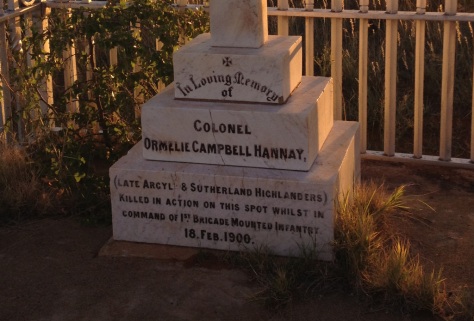
Travelling further along the road, with the sun starting to dip towards the horizon, we were on the verge of calling it a day, when we saw a further site with a number of graves and stopped to investigate – it turned out to be the site of a monument to the Burgers (Boers) who had died at Paardeberg.
While we were stopped, a local farmer who introduced himself as “SF” Marais, turned up in his bakkie (pickup) and in broken English and his home language of Afrikaans told us a bit about the area and that his family had farmed the area for more than 100 years. He gave us directions to some of the other sites where the “Engelse” (the British forces) were buried on the other side of the Modder River, which we thought would be good place to visit the next day.


By now it was close to dark and we ended up investigating the Paardeberg battle site with a torch, after which we headed back to Kimberley for a late check-in at the Cecil John Rhodes guest house – the managers had tired of waiting for us so we had to wait for them to return and open up. After a decent meal at Mario’s across the road we collapsed into bed.


Return to Paardeberg
After spending some time in the recreated village adjoining the famous Big Hole of Kimberley, we headed back to Paardeberg with the main mission of finding what John had come for – the graves of the Canadian soldiers who died in the battle.
After spending some time on the southern side of the Modder River where we found a large grave site but no sign of the Canadians, we found our way back to the northern side of the river where we had been the previous evening and carried on in the direction that SF Marais had said more of the “Engelse” were buried.
It was with much excitement that we found the site at the last brown “Cannon” sign, indicating a battlefield site, and discovered that the Canadian soldiers had been buried there. John and Sam and indeed myself, were thrilled to find what they had come such a long way to see, while at the same time feeling sad for the losses incurred on both sides.


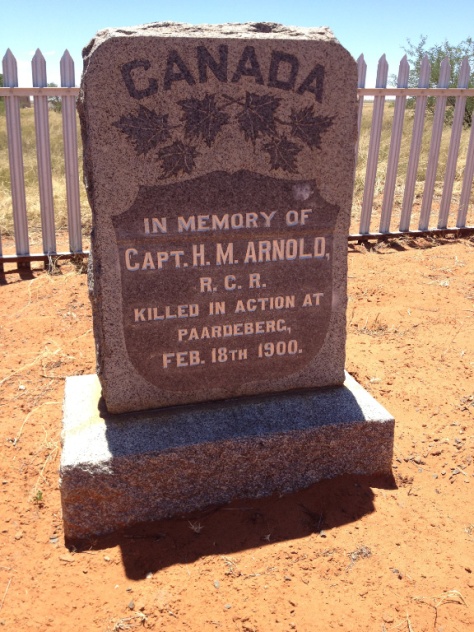

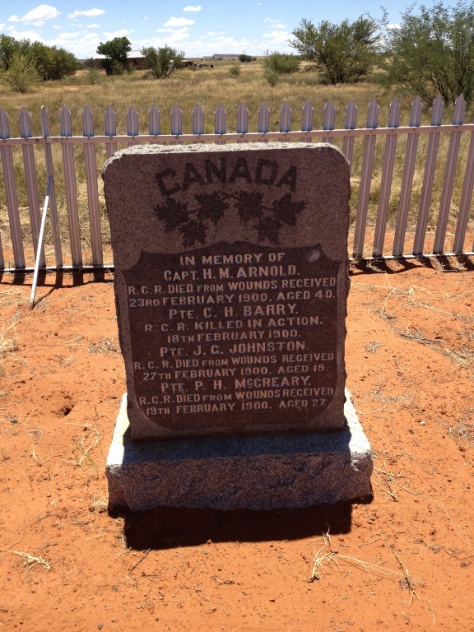


Excited by our find, which had proved to be challenging on these back roads and with very little signage to guide us, we proceeded to Bloemfontein and back to Pretoria via Ventersburg, Kroonstad and Johannesburg, eventually arriving at 7.30 pm, having travelled some 1400 Kms in the 2 days. Mission accomplished!

The Battle
The Battle of Paardeberg began on 17 February 1900 and was to become the longest and biggest battle of the Anglo-Boer War (1899-1902), ending with the Boers under General Piet Cronje surrendering on 27 February 1900. The British forces under command of Lord Kitchener surrounded the Boers at Paardeberg – the next morning Lord Roberts took charge to continue with the battle. The Boer forces lost 100 men, 250 were wounded and 4096 captured. British forces lost 258 men with 1211 wounded and 86 taken prisoner.
Where is it?
This is one of the more difficult sites to find but it’s best to visit the little museum first and then ask directions from there. The museum is at 28° 59′ 1″ S / 25° 4′ 48″ E and the battlefield and grave sites are mostly along the same gravel road heading east – just don’t give up too soon, as you have to travel quite a few Kms before you come across the sign to where the Canadians are buried. To get to the southern side of the battlefield, return to the N8, head towards Bloemfontein and just after the bridge over the Modder river, turn left and follow the gravel road, keeping a look out for the sites, some of which are signposted.
The Big Hole, Kimberley
During our quick visit we managed to fit in a visit to the “Big Hole” museum complex, where we were fortunate to just catch the 9 am tour. The guide took us to the auditorium for an excellent film introduction to the history of the Big Hole, then out onto the viewing deck overlooking the gigantic hole and finally “down” the mine shaft to a reproduction of the original mine workings.
Out on the deck I looked for Bradfield’s Swifts which are known to frequent the hole and found a couple fairly easily among the Alpine and Little Swifts, which seemingly also use the open air above the big hole for feeding on small flying insects.

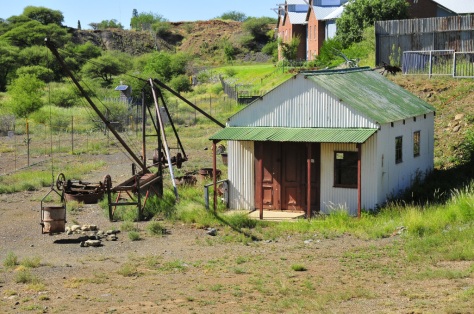
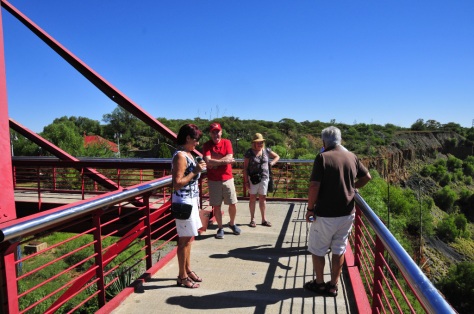



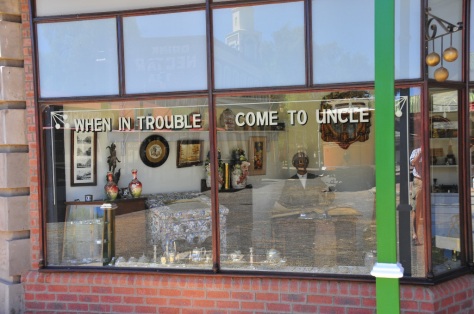
A Bit of Birding
Birding was a side issue on this trip, limited to some snatched sightings while travelling and when investigating the battlefield sites. A couple of short ad hoc pentad lists were submitted, which included a Familiar Chat (being a new species on the one list) and a handsome Pale Chanting Goshawk perched on a pole. On the other list 3 out of the 5 species were Swallows – Greater-striped, SA Cliff and Barn Swallows.

As usual, great photos and useful information…more than I learnt at school! Well done Don
Thanks Andrew – the battlefields were a lot more interesting than I thought
When looking at the numbers of lives lost, it brings renewed respect for a generation of heroes! Thanks for bringing a part of history closer to home!
And a lot of the soldiers were still in their teens
A well told story!! And the pictures are amazing.
Thanks Sarah – your Dad was an inspiration!
Thanks so much for posting all this. For a long time now, I have been searching for the grave of my great grandfather, Sgt James Todd of the Buffs and in the 2nd photo in your “Return to Paardeberg” paragraph I see his name. Now all I have to do is to locate that cemetary! As a strange coincidence, another J Todd fell on the same day in the same battle, he was from a Canadian regiment. Thanks again for all your work.
Glad it helped you! I would probably be able to find the cemetery’s position on google earth if you want to visit it
Thanks.very Interesting I am researching Thomas Carney from Halifax UK.
OK – was he involved in this battle?
Don, I have posted your very interesting blog on my Facebook page, which is about the Canadians at Paardeberg.
Don, I have posted a link to your very interesting blog on my Facebook page, which is about the Canadians at Paardeberg. The link to my page is: https://www.facebook.com/Paardeberg/
That’s great Martin. Since touring the battlefields with my Brother-in-law John Denner from Canada, I have read a few books dealing with that period and have learnt a lot. I will make sure to buy your book and mention it to John. We were in Canada about two years ago and saw John’s magnificent museum with a collection of Canadian military uniforms and memorabilia that is probably unsurpassed anywhere.